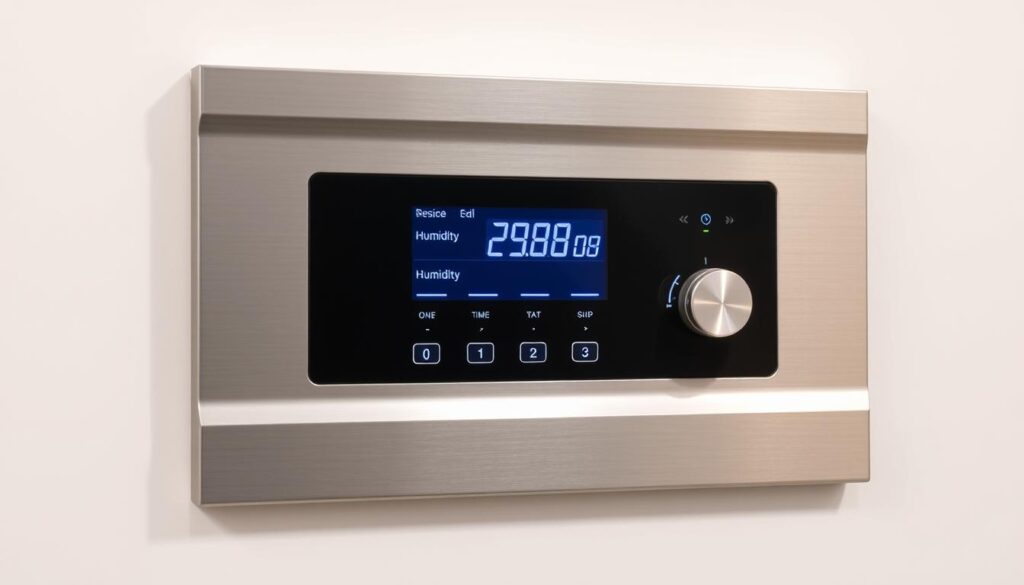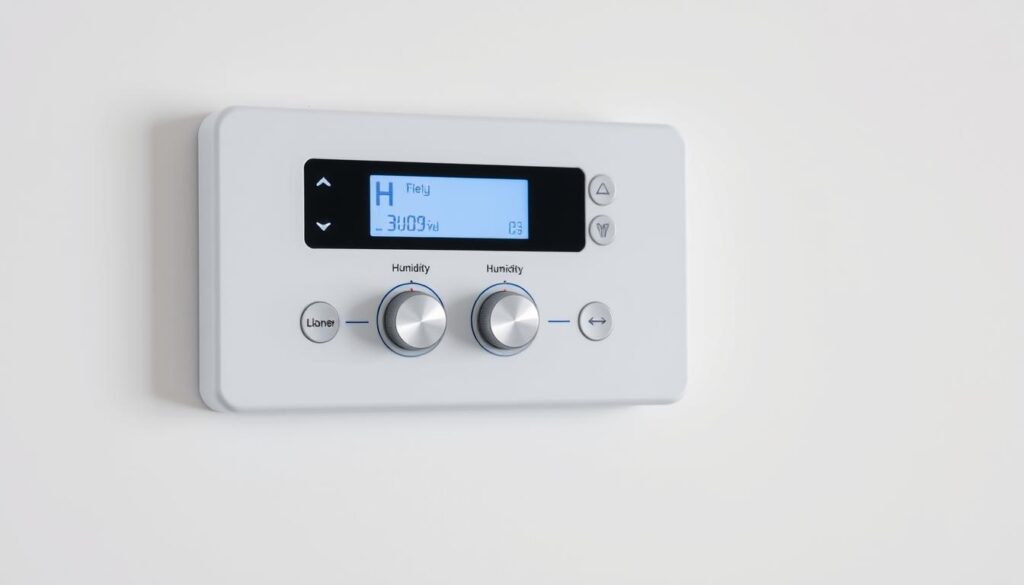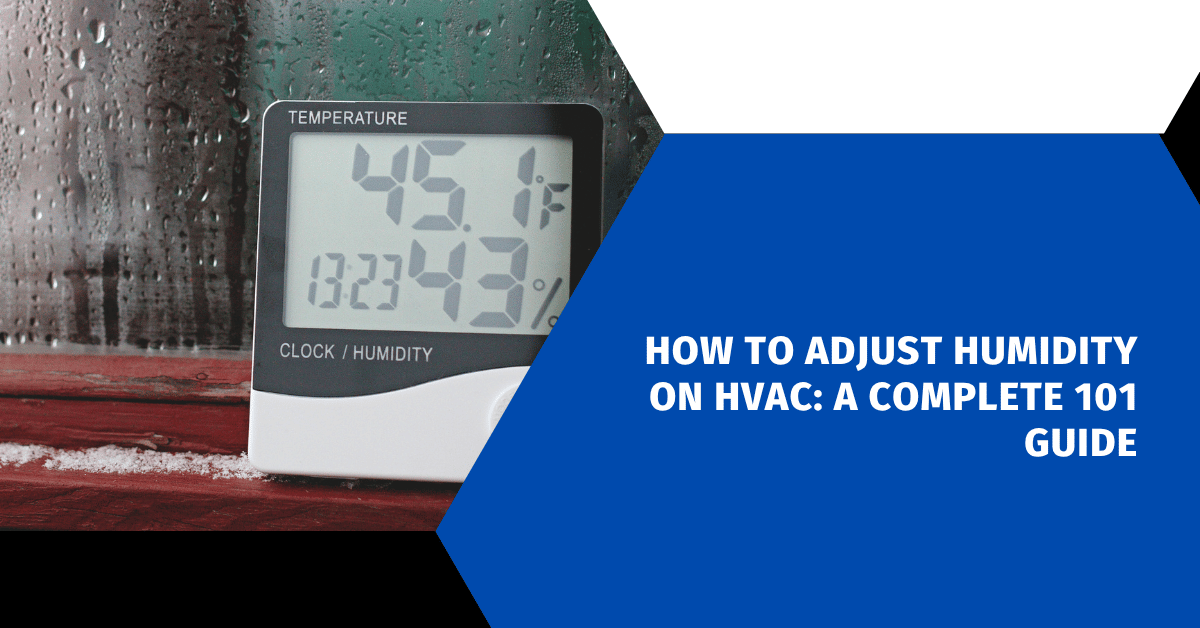Affiliate Disclosure
HVAC Guide Guys is a participant in the Amazon Services LLC Associates Program, an affiliate advertising program designed to provide a means for sites to earn advertising fees by advertising and linking to Amazon.
How to Adjust Humidity on HVAC? Ever felt like your home is too sticky or too dry? It might be because of your HVAC system’s humidity control. Keeping the right moisture balance is key for comfort and health.

Your HVAC system does more than just heat or cool your home. It also controls humidity levels, affecting air quality and your health. The ideal humidity is between 40-50% to avoid health and comfort problems.
Adjusting humidity on your HVAC is easy with the right tips. This guide will show you how to make your home’s air just right. You’ll learn all about managing moisture in your home’s air system.
Key Takeaways
- Proper humidity control is essential for indoor comfort
- HVAC systems can help manage moisture levels effectively
- Humidity impacts health, air quality, and home environment
- Different seasons require different humidity strategies
- Regular HVAC maintenance supports optimal humidity control
Table of Contents
Understanding HVAC Humidity Control Basics
Managing HVAC moisture levels is key to a comfy and healthy home. Your home’s humidity affects comfort and air quality. Knowing how to control humidity helps keep your home perfect.
Relative humidity (RH) shows how much moisture is in the air. It’s like a sponge that can only hold so much water before it’s full.
What Exactly is Relative Humidity?
To set the right indoor humidity, you need to get RH. It’s a percentage that shows how wet the air is. Comfort usually falls between 40-60% RH.
Ideal Indoor Humidity Ranges
- Winter: 40-50% RH at temperatures between 68°F – 74°F
- Summer: 50-60% RH at temperatures between 73°F – 79°F
- Optimal comfort zone: Consistent 45-55% relative humidity
“Controlling indoor humidity is not just about comfort, it’s about creating a healthy living environment.” – HVAC Experts
Impact of Humidity on Indoor Comfort
Right humidity levels make your home comfy and healthy. Too much humidity can cause:
- Mold growth
- Increased dust mite populations
- Musty odors
- Potential respiratory issues
Too little humidity can lead to:
- Dry skin
- Respiratory discomfort
- Static electricity
- Increased susceptibility to colds
By managing HVAC moisture levels, you can make your home comfy and healthy all year.
How Your HVAC System Manages Moisture Levels
Your HVAC system does more than just cool your home. It also manages moisture levels, making your indoor space comfortable. The cooling process is key here, as your air conditioner pulls out extra moisture from the air.
To understand how your system controls humidity, look at the evaporator coil. It’s like a moisture catcher. Warm air hits these cold coils, and water vapor turns into liquid, lowering indoor humidity.
- Evaporator coils cool air below its dew point
- Condensed moisture is collected and drained away
- Air temperature and humidity are simultaneously regulated
Different HVAC systems handle moisture in their own ways. Central air units usually remove more moisture than window units. The system’s success depends on several things:
- Size of the HVAC unit
- Age of the equipment
- Regular maintenance
Good humidity control makes your home more comfortable. It also stops problems like mold and poor indoor air quality.
Common Signs of Humidity Problems in Your Home
Your home’s humidity levels can greatly affect your comfort and health. It’s important to control humidity with HVAC systems to keep your home healthy. Knowing the right humidity range helps spot moisture issues early.
High Humidity Warning Signs
Too much moisture in your home can cause many problems. Watch for these signs:
- Visible condensation on windows and mirrors
- Musty or damp odors
- Mold growth on walls, ceilings, or furniture
- Peeling wallpaper or paint
- Warped wooden surfaces
Low Humidity Warning Signs
On the other hand, too dry air can also be a problem:
- Persistent static electricity
- Dry, itchy skin
- Increased respiratory irritation
- Cracked wooden furniture
- Frequent static shocks
Health and Comfort Effects
Keeping the right humidity in your home is key for your health. The wrong humidity can lead to:
| Humidity Level | Potential Health Impacts |
|---|---|
| Above 70% | Increased risk of mold, respiratory issues, allergies |
| Below 30% | Dry skin, respiratory discomfort, increased virus transmission |
| 40-50% | Ideal comfort and health conditions |
Pro tip: Regular HVAC maintenance helps manage your home’s humidity. This ensures a comfortable and healthy living space.
Explore Our HVAC Shop
Looking for top-rated HVAC tools, parts, and accessories? Visit our shop and find the perfect solution for your needs.
Visit the ShopHow to Adjust Humidity on HVAC

Keeping your home’s humidity at the right level is key for comfort and clean air. Learning how to adjust your HVAC’s humidity settings can greatly improve your home’s atmosphere.
Your HVAC’s humidifier and dehumidifier settings are vital for the right moisture levels. First, get to know your system’s humidity control features:
- Check your thermostat’s humidity control settings
- Adjust fan speed to manage moisture removal
- Use integrated humidity sensors
There are several ways to control indoor humidity well:
| Method | Humidity Control Technique | Effectiveness |
|---|---|---|
| Fan Speed Adjustment | Lower fan speed for moisture removal | High |
| Evaporator Coil Management | Optimize coil temperature | Medium-High |
| Thermostat Programming | Set specific humidity levels | High |
Pro tip: Be careful when changing settings to avoid overloading your system. A professional HVAC technician can offer tailored advice for your system.
Remember, controlling humidity right not only makes your home more comfortable. It also helps protect it from moisture damage.
Understanding Your HVAC’s Dehumidification Process
Managing moisture levels in your HVAC is complex. It involves many parts working together. Your HVAC system is key to keeping your home’s humidity just right by removing extra moisture from the air.
The dehumidification process starts with several important steps. These steps make humid air comfortable for you. Knowing how these steps work can help you improve your HVAC’s humidity control.
Evaporator Coils: The Moisture Removal Powerhouse
Evaporator coils are the main part for removing moisture in your HVAC. They cool the air as it passes through. This causes water vapor to condense on the cold surface, lowering indoor humidity effectively.
Condensation and Drainage Dynamics
When humid air hits the cold evaporator coils, water droplets form. These droplets are key in managing hvac moisture levels. The moisture follows a specific path:
- Water condenses on the coils
- Droplets collect in a drain pan
- Liquid is channeled through a drain pipe
- Moisture is safely removed from your home
Airflow: The Unsung Hero of Dehumidification
Good air circulation is vital for controlling humidity. Your HVAC system uses airflow to:
- Maximize moisture extraction
- Prevent humidity buildup
- Maintain consistent indoor comfort
By understanding these detailed processes, you can see how your HVAC system works hard. It keeps your indoor environment comfortable and free of humidity.
Explore Our HVAC Shop
Looking for top-rated HVAC tools, parts, and accessories? Visit our shop and find the perfect solution for your needs.
Visit the ShopEssential Fan Speed Adjustments for Humidity Control
Managing fan speed is key to controlling humidity in your home. It affects both comfort and energy use. Your HVAC system’s fan helps keep humidity levels right and air quality good.
Knowing how to adjust fan speeds is important. Different speeds offer different benefits:
- Low Speed: Removes moisture best
- Medium Speed: Balances cooling and dehumidifying
- High Speed: Moves air fast but takes less moisture
Running your fan slower lets it pull more moisture from the air. This makes your home feel more comfortable. Slower fan speeds mean longer cooling cycles, which is better for removing moisture.
“Proper fan speed adjustment is like finding the perfect rhythm for your home’s comfort” – HVAC Comfort Experts
Here are some tips for adjusting fan speed:
- Try different fan speeds in humid seasons
- Use a hygrometer to check indoor humidity
- Change fan speeds with outdoor temperature and humidity
Remember, slower fan speeds might use a bit more energy. But finding the right balance is crucial. It keeps your home comfortable and saves on energy.
Smart Thermostat Settings for Optimal Humidity
Smart thermostats have changed how we control our home’s climate. They do more than just set the temperature. They also control humidity, making our homes more comfortable and energy-efficient.
These thermostats have advanced sensors. They keep an eye on the humidity in your home. They adjust it automatically to keep it just right.
Programming Your Thermostat for Optimal Humidity
To get the most out of your smart thermostat, follow these tips:
- Set specific humidity targets for different times of day
- Create custom schedules based on room occupancy
- Integrate with other smart home devices for comprehensive climate control
Seasonal Adjustment Tips
Humidity changes with the seasons. Your smart thermostat can help you adjust:
| Season | Recommended Humidity Range | Smart Thermostat Strategy |
|---|---|---|
| Summer | 40-50% | Activate dehumidification mode |
| Winter | 30-40% | Use humidification settings |
| Spring/Fall | 45-55% | Enable adaptive humidity control |
Pro tip: Many smart thermostats work with mobile apps. This lets you change humidity settings from anywhere. You also get updates on your home’s climate.
Explore Our HVAC Shop
Looking for top-rated HVAC tools, parts, and accessories? Visit our shop and find the perfect solution for your needs.
Visit the ShopMaintaining Your HVAC for Better Humidity Control

Keeping your HVAC system in top shape is key for controlling humidity. Regular maintenance stops excess humidity and keeps your system running well. Dirty parts can really hurt your system’s ability to handle moisture in your home.
Your HVAC system needs regular care to work its best. To stop excess humidity, focus on a few important tasks:
- Clean or replace air filters every 1-3 months
- Inspect evaporator coils for dirt and debris
- Check drainage systems for clogs
- Ensure proper airflow around indoor and outdoor units
Evaporator coils are very important for managing humidity. When these coils get dirty, they can’t pull moisture from the air well. This makes your system cool less and dehumidify less effectively.
| Maintenance Task | Frequency | Impact on Humidity Control |
|---|---|---|
| Air Filter Replacement | Every 1-3 months | Improves air quality and system efficiency |
| Coil Cleaning | Annually | Enhances moisture removal capabilities |
| Drainage System Check | Twice a year | Prevents moisture backup and potential damage |
Professional HVAC maintenance can spot problems early. Think about getting a pro to check your system every year. This ensures it keeps your home comfortable and controls humidity well.
Troubleshooting Common Humidity Control Issues
Managing HVAC humidity control can be tough for homeowners. Your comfort and system efficiency depend on quick fixes for moisture problems. Knowing these issues helps keep your indoor air quality good and prevents damage to your home.
System Size Complications
An HVAC system that’s too big can cause big problems. It leads to:
- Rapid cycling of the compressor
- Insufficient dehumidification time
- Uneven temperature distribution
- Higher energy consumption
Ventilation Challenges
Poor ventilation traps moisture in your home. This can make your home uncomfortable and even harmful. Watch out for these signs:
- Persistent musty odors
- Visible condensation on windows
- Mold growth in corners or bathrooms
- Unexplained respiratory issues
Maintenance-Related Issues
Regular maintenance is key for good humidity control. If you ignore your HVAC, it can lead to serious problems. These problems can hurt your indoor air quality.
Proactive maintenance prevents 70% of humidity-related HVAC performance issues.
Important maintenance tasks include cleaning air filters and checking drainage systems. Also, don’t forget to schedule professional inspections. Fixing these issues early can save you a lot of time and money.
Explore Our HVAC Shop
Looking for top-rated HVAC tools, parts, and accessories? Visit our shop and find the perfect solution for your needs.
Visit the ShopAdding Supplemental Humidity Control Devices
Supplemental devices can be a big help when your HVAC system can’t keep humidity just right. Standalone humidifiers and dehumidifiers can tackle moisture issues your central air can’t handle.
Choosing the right device depends on your home’s unique needs. The settings on your HVAC humidifier and dehumidifier greatly affect comfort and air quality.
- Whole-House Humidifiers: These are part of your HVAC system, spreading moisture evenly
- Portable Humidifiers: Great for single rooms or small areas
- Whole-House Dehumidifiers: Keep moisture levels down to prevent mold
- Standalone Dehumidifiers: Best for damp places like basements and bathrooms
When picking a device, think about these important points:
- How big is the room?
- What’s the humidity like in your home?
- Will it work with your HVAC system?
- Is it energy-efficient?
Now, smart home tech lets you link humidity control devices with your HVAC. Smart thermostats can connect to humidifiers and dehumidifiers. This creates a system that adjusts to your environment.
Pro tip: Regular maintenance of your supplemental humidity devices ensures optimal performance and extends their operational lifespan.
Conclusion
Learning how to adjust humidity on HVAC systems is key for a comfy and healthy home. Your HVAC system controls moisture levels inside, affecting comfort and air quality.
The best humidity range for your home is between 30% and 50%. To get there, you need to manage your system well. This includes the right installation, sizing, and fan speed settings. Smart thermostats and extra devices help fine-tune your home’s climate.
Keeping your HVAC system in check is vital for long-term moisture control. Regular checks, clean filters, and quick fixes stop moisture problems. By following this guide, you can make your home more comfortable and healthy, and maybe even save on energy costs.
With new HVAC tech, you have better tools to manage humidity. Keep up with the latest tech and tips to keep your system running smoothly and your home climate perfect.

